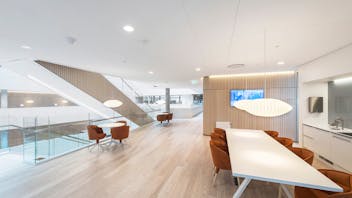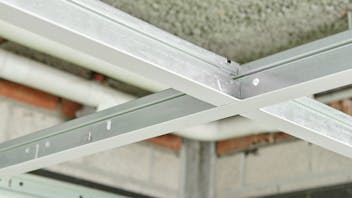Acoustic ceiling installation and most commercial suspended ceiling constructions consist of metal channels in the shape of an upside-down T. These upside-down T’s are commonly referred to as mains runners or cross runners/cross tees and are suspended on wires from the overhead structure, creating a space between the buildings structure and the finished ceiling called a plenum. These main runners and cross tees are connected to one another in a regularly spaced pattern of cells or modules, once connected the system they create is often just referred to as ceiling grid.
These cells are filled with ceiling panels. Our stone wool acoustic tiles are available in a wide range of module sizes, ranging from the industry standard 2x2’ and 2x4’ all the way up to large 4x4’ and 2x8’ options. They provide lightweight solutions which are easy to handle, cut and install. Rockfon specialty metal ceiling panels and planks provide another durable solution with a wide range of styles, finishes, and aesthetics to allow for unique design expressions. These ceiling tiles, panels, boards and planks conceal and provide access to the plenum above them while providing enhanced acoustical performance, humidity and fire resistance, light reflection and indoor air quality.
As an alternative to installing a suspended ceiling that conceals, open plenum ceiling systems often are used in many room types to provide the feel of a more open space which exposes the mechanic or surface elements within the plenum. In addition, hanging baffles, islands and clouds may be used to enhance acoustics when a drop ceiling mount is not practical.
Installation of a suspended ceiling – how to install suspended ceiling grid.
Installation methods of ceiling suspension systems on commercial buildings are enforced by ASTM C636 “Standard Practice for Installation of Metal Ceiling Suspension Systems for Acoustical Tile and Lay-In Panels.”1
- Main runners (main tees) directly suspended with hanger wires to the above substrate.
- Cross runners (cross tees) connected to the main tees via their respective end details, which click or hook into themselves in the evenly spaced, punched features in the main runners.
- Wall angles are used to support the ceiling board in the cells created by the main and cross runners.
Perimeter trim is located at the periphery of wall-to-wall ceilings. It can be used as wall molding or as trim encasing the suspended ceiling in a cloud design.2
Ceilings & Interior Systems Construction Association (CISCA) also publishes industry-accepted practices for proper methods of installing various types of systems. According to the CISCA Ceiling Systems Handbook, suspended ceiling instructions begin with becoming familiar with the building and any special or unusual conditions.3
Remember that special and unusual conditions may be invisible or even beyond the building’s exterior walls. For example, the U.S. International Building Code requires Seismic Design Categories be assigned to all building projects, and references ASTM E580 “Standard Practice for Installation of Ceiling Suspension Systems for Acoustical Tile and Lay-in Panels in Areas Subject to Earthquake Ground Motions.”4
Whether your project requires you to understand the complexity of a seismic separation joint clip or the simplicity of how to install suspended ceiling 2x2 ceiling tiles, every project deserves a ceiling solution that is properly installed to meet its performance and aesthetic goals.
Sources
1, 2. https://www.astm.org/Standards/C636.htm
3. https://www.cisca.org/i4a/pages/index.cfm?pageid=3281
4. https://www.astm.org/Standards/E580.htm












